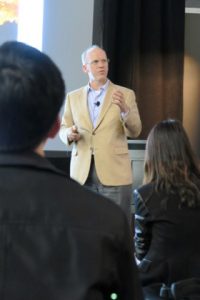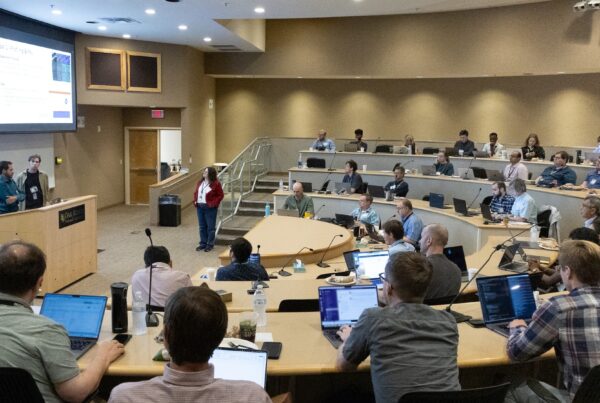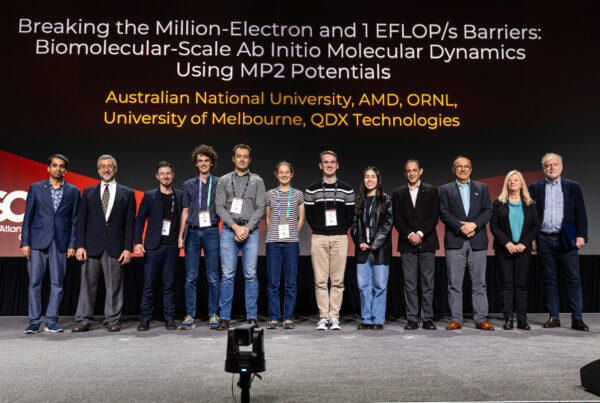
OLCF Director of Science Jack Wells speaks to a group at the NVIDIA GPU Technology Conference about the present and future of leadership-class computing at the OLCF.
Staff plays prominent role by presenting papers and giving talks about current and next-generation supercomputers
Staff members from the Oak Ridge Leadership Computing Facility (OLCF) had a strong presence at one of the world’s premier high-performance computing conferences, the GPU Technology Conference (GTC), hosted by NVIDIA.
The conference, which took place March 17–20 in Silicon Valley, brought together GPU developers and users to more effectively use GPU technology for a variety of purposes.
The main goal for OLCF staff was to provide knowledge and resources about Titan, the nation’s fastest computer, using GPUs to accelerate performance.
The OLCF holds a unique position as a leader in GPU-accelerated computing, according to Jack Wells, director of science at the National Center for Computational Sciences (NCCS) at the US Department of Energy’s (DOE’s) Oak Ridge National Laboratory. “CEO Jen-Hsun Huang highlighted NVIDIA’s strong growth in high-performance computing during his keynote address,” Wells said. “It is clear that Titan’s users are a big part of this growth. For example, I was interested to learn during this keynote that Titan represents fully one-half of the deployed petaflops of the NVIDIA Tesla market. The buzz at the meeting around our Summit project was also very noticeable.”
The Cray XK7 Titan supercomputer at the OLCF—a US Department of Energy Office of Science User Facility—is capable of 27 petaflops, or 27 quadrillion calculations per second. Titan was the first leadership-class computer to leverage GPU technology. The OLCF also sees GPUs as an essential component moving forward—the next-generation supercomputer at the OLCF, Summit, also will leverage GPUs to achieve an increase over Titan’s computational capabilities. Summit will be completed in 2018.
In the spirit of heterogeneous supercomputing architectures present and future, OLCF staff members gave a variety of presentations relating to the OLCF’s GPU usage.
Jim Rogers, NCCS director of computing and facilities, discussed GPU errors on high-performance computing systems. Rogers went into detail about the resiliency of Titan’s NVIDIA K20x Kepler GPUs.
Wells led one session about the present and future of leadership-class computing resources at the OLCF and helped organize several other talks featuring speakers who have leveraged OLCF resources for insight in a variety of domains: Ravi Srinivasan from Dresser-Rand spoke about designing turbomachinery using Titan; Russell DeVane from Procter & Gamble discussed using GPUs to model lipid membrane systems, such as those found in the soaps and shampoos for which P&G is so well known; and Jeremiah Lee from United Technologies Research Center spoke about combustion research using heterogeneous computing architectures.
In addition to industry professionals, users from other institutions also talked about Titan. James Phillips and John Stone of the University of Illinois at Urbana-Champaign both gave talks, with Phillips’ centered around about how his research group uses petascale computing to find ways to combat HIV, and Stone’s dealt with VMD, a popular molecular graphics program. Evghenii Gaburov of Netherlands-based SURFsara spoke about high-performance in situ visualizations on high-performance computers. Cray’s Aaron Vose gave a talk about porting computational physics applications to Titan.
Tjerk Straatsma, manager of the OLCF’s Science Computing Group, discussed the Center for Advanced Application Readiness at the OLCF and how staff is working with users to prepare scientific applications for running on Summit.
OLCF user support specialist Fernanda Foertter led a session on the OLCF’s 2014 Hackathon, an event aimed at scaling scientific applications to run on heterogeneous, high-performance computing systems such as Titan. OLCF user support specialist Adam Simpson spoke on his experiences as a mentor.
In addition, Foertter also took part in a panel on women at GTC, which was also visited by NVIDIA CEO Jen-Hsun Huang. She also participated in a panel about OpenACC, which has been an important tool for Titan and its users for two years. It has allowed researchers to attain a high level of parallelism/performance from their code, resulting in improved time to solutions and higher fidelity simulations.
Staff members also participated in the first OpenPower Summit in collaboration with GTC. The Open Power Summit brought experts on power computing architectures together for collaboration and sharing best practices. Straatsma spoke about the next peak in high-performance computing and described the OLCF’s efforts to prepare users and staff for the next-generation system.
In addition to OLCF staff involvement in the program, a team of OLCF users from the San Diego Supercomputer Center won NVIDIA’s 2015 Global Impact Award for their work using Titan to simulate a large earthquake in California at high frequencies to help prepare structural engineers.
For more information on the GTC conference, please visit: https://www.gputechconf.com/.
Oak Ridge National Laboratory is supported by the US Department of Energy’s Office of Science. The single largest support of basic research in the physical sciences in the United States, the Office of Science is working to address some of the most pressing challenges of our time. For more information, please visit science.energy.gov.






